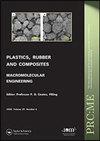二甲丙烯酸锌浓度对乳液型丁苯橡胶/丁二烯橡胶共混物性能的影响
IF 1.2
4区 材料科学
Q3 MATERIALS SCIENCE, COMPOSITES
引用次数: 0
摘要
研究了二甲丙烯酸锌(ZDMA)对乳液型丁苯橡胶/丁二烯橡胶(ESBR/BR)共混物性能的影响。结果表明,复合材料的转矩差、硬度、强度和总/离子交联密度均有所增加;断裂伸长率和共价交联密度随ZDMA的增加而降低。随着ZDMA的增加,共混物的离子交联密度逐渐增大。在ZDMA浓度为12.5 phr时,该化合物的拉伸强度和撕裂强度最佳。在ZDMA的5和7.5 phr下,共混物表现出明显的良好的愈合效率,扫描电子显微镜(SEM)和手动视频测量机(VMM)等表征测试支持了这一结果。傅里叶变换红外光谱(FTIR)分析表明,共混物中存在ZDMA。ZDMA的动态离子键有助于共混物的自修复性能。锌离子对构成离子簇和离子簇,形成离子超分子网络。本文章由计算机程序翻译,如有差异,请以英文原文为准。
Effect of zinc dimethacrylate concentrations on properties of emulsion styrene butadiene rubber/butadiene rubber blends
ABSTRACT The influence of zinc dimethacrylate (ZDMA) on the properties of emulsion styrene butadiene rubber/butadiene rubber (ESBR/BR) blends was studied. Results revealed that torque difference, hardness, strengths, and total/ionic crosslink densities increased; whereas the elongation at break and covalent crosslink density reduced with increasing ZDMA. As ZDMA increased, the ionic crosslink density of the blends gradually increased. Optimum tensile and tear strength of the compound were observed at 12.5 phr of ZDMA. At 5 and 7.5 phr of ZDMA, the blends showed significant good healing efficiency, supported by the characterization tests such as scanning electron microscopy (SEM) and manual video measuring machine (VMM). Fourier-transform infrared spectroscopy (FTIR) analysis showed the presence of ZDMA in the blends. The dynamic ionic bond of ZDMA contributed to the self-healing properties in the blends. The zinc ions pair constituted the ion multiplet and ionic clusters, forming an ionic supramolecular network.
求助全文
通过发布文献求助,成功后即可免费获取论文全文。
去求助
来源期刊

Plastics, Rubber and Composites
工程技术-材料科学:复合
CiteScore
4.10
自引率
0.00%
发文量
24
审稿时长
4 months
期刊介绍:
Plastics, Rubber and Composites: Macromolecular Engineering provides an international forum for the publication of original, peer-reviewed research on the macromolecular engineering of polymeric and related materials and polymer matrix composites. Modern polymer processing is increasingly focused on macromolecular engineering: the manipulation of structure at the molecular scale to control properties and fitness for purpose of the final component. Intimately linked to this are the objectives of predicting properties in the context of an optimised design and of establishing robust processing routes and process control systems allowing the desired properties to be achieved reliably.
 求助内容:
求助内容: 应助结果提醒方式:
应助结果提醒方式:


